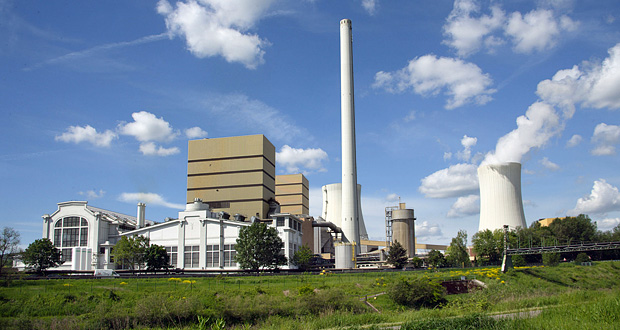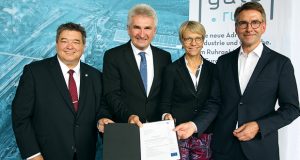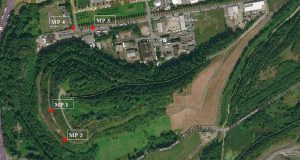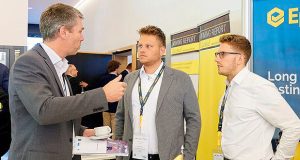Fenne HydroHub is set to become a living laboratory for the energy transition. The project outline, which was developed by STEAG GmbH, Essen/Germany, jointly with project partners Siemens AG, the Institute for Future Energy and Material Flow Systems (IZES gGmbH) and the German Research Centre for Artificial Intelligence (DFKI GmbH) and entered in the competition held by the German Federal Ministry for Economic Affairs and Energy (BMWi), was selected from amongst 90 entries and judged to be eligible for support. On 19th July 2019 in Berlin, Peter Altmaier (CDU), Federal Minister for Economic Affairs, thereby highlighted that Fenne HydroHub is an important building block for a successful energy transition in Germany in the future.
During a press conference given by Altmaier, a total of 20 projects were invited to submit official applications for funding. “This is a great success for the project community and underlines our strategy: STEAG is making pertinent contributions to the energy transition at power plants located in Saarland and in North Rhine-Westphalia,” says Wolfgang Cieslik, Member of the Board of STEAG with responsibility for the Market and Technology segment. The Federal Ministry will provide the selected projects with a total of 100 M € of support until 2025. This is planned to start from the coming year.
The project partners entered the BMWi “Living Labs for the Energy Transition” competition with their “Fenne HydroHub” project outline. The German government is aiming to accelerate the expansion of hydrogen technologies and the establishment of integrated energy solutions, and make them ready for the market. “With this innovative hydrogen infrastructure project, we wish to show a route towards the necessary further development of the energy transition, as well as to develop recommendations for the regulatory framework conditions for the economic construction and operation of this type of CO2-free system,” says Prof. Thomas Thiemann, Director of the Energy Transition Technologies Team at project partner Siemens Gas&Power.
With the phase-out of nuclear power production in 2022 and the planned end of coal-fired power generation in 2038, one thing is certain: Wind and solar energy will be the main pillars of electricity supply in Germany in the future. However, both renewable energy sources are subject to weather-related fluctuations. As an energy medium, hydrogen can balance out these fluctuations. At the STEAG power station in Völklingen-Fenne (Figure 1), this is to take place at an energy hub where the electricity grid, the district heating grid and a gas pipeline run together. “The term “integrated energy solutions”, which up until now has been seen as the theoretical key to making the energy transition successful, is a reality at our plant,” says Cieslik.
And this is how the project outline looks: In periods of excess supply of wind and solar energy at the STEAG power station, the project partners generate hydrogen using an electrolyser. This energy source can then be used in various ways thanks to the integration of electricity and gas grids, industry and transport. The hydrogen is supplied to nearby steelworks, e. g., which require it for industrial processes. It is fed into the regional gas network and also supplies public hydrogen filling stations for fuel cell vehicles in Saarland. The hydrogen can also be turned into electricity later. The heat which is generated during the production of the hydrogen is extracted from STEAG into the Saar District Heat grid.
The electricity-based production of hydrogen (electrolysis) is intended to be conducted on an industrial scale using renewable energies. Electricity from wind and solar power is used to split water into oxygen and “green hydrogen” by electrolysis. The hydrogen can then be used as a substitute for fossil fuels, making energy production CO2-free. For energy-intensive industries such as steel and chemicals, the use of hydrogen can be a decisive step towards better environmental compatibility and climate neutrality. With the “Fenne -HydroHub”, the four partners in the project are creating a prototype that can also be implemented at other locations across Germany. In addition to reducing CO2 emissions, this will also create new jobs. They estimate an investment volume in the mid two-digit million range.
The four partners are breaking new ground in Völklingen-Fenne, since the interaction of various components and systems is being tested on an industrial scale for the first time. A new electrolyser, a large hydrogen storage tank and a new high-temperature heat pump come together with an existing large-scale battery system, a mine gas engine cogeneration plant and an electrode boiler at this energy hub. This means that all the necessary connections to electricity, heat and gas networks are available and usable. In addition, STEAG is considering the construction of a combined cycle power plant at the Fenne site, in which hydrogen can be converted back to electricity on a large scale in a gas turbine. (STEAG/Si.)



